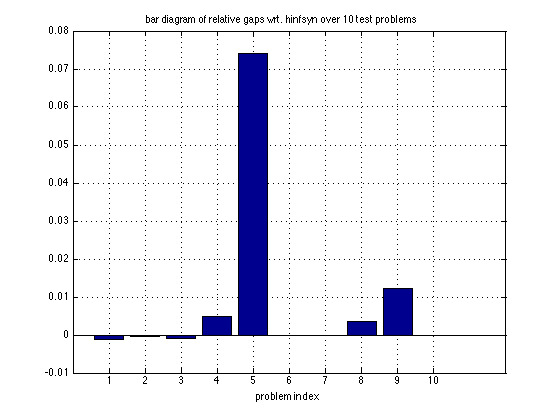hinfstruct vs. hinfsyn. Do the stats.
Compare hinfsyn and hinfstruct for controllers of the same order over nRand randomized problems.
Contents
Generate problems and run hinfstruct and hinfsyn
nRand = 10; % number of random problems nx = 8; ny = 3; nu = 2; nw = 2; nz = 3; % plant dimensions gamHINFSTRUCT = zeros(nRand,1); gamHINFSYN = zeros(nRand,1); for ii=1:nRand P = rss(nx,nz+ny,nw+nu); % generate random plant C0 = ltiblock.ss('C0', nx, nu, ny); % state-space controller of order nx CL0 = lft(P,C0); % Run |hinfstruct|with 2 extra starting points op = hinfstructOptions('RandomStart', 2) ; % add 2 starting points [CL1,gamHINFSTRUCT(ii)] = hinfstruct(CL0, op); % CL1 is tuned version of CL0 Cfinal = getNominal(C0, CL1); % retrieve final controller gamHINFSTRUCT(ii) = norm( lft(P,Cfinal), inf); % recompute to double check % Run |hinfsyn| [K,CL2,gamHINFSYN(ii)] = hinfsyn(P,ny,nu) ; gamHINFSYN(ii) = norm( lft(P,K), inf); % recompute to double check end
Final: Peak gain = 0.993, Iterations = 39
Final: Peak gain = 0.993, Iterations = 35
Final: Peak gain = 0.993, Iterations = 41
Final: Peak gain = 1.58, Iterations = 44
Final: Peak gain = 1.58, Iterations = 66
Final: Peak gain = 1.58, Iterations = 42
Final: Peak gain = 3.59, Iterations = 23
Final: Peak gain = 3.59, Iterations = 27
Final: Peak gain = 3.59, Iterations = 18
Final: Peak gain = 4.72, Iterations = 185
Final: Peak gain = 4.71, Iterations = 300
Final: Peak gain = 4.72, Iterations = 144
Final: Peak gain = 3.22, Iterations = 91
Final: Peak gain = 3.23, Iterations = 54
Final: Peak gain = 3.24, Iterations = 54
Final: Peak gain = 2.97, Iterations = 71
Spectral radius 1.12e+05 is close to bound 1.45e+05
Final: Peak gain = 2.96, Iterations = 65
Final: Peak gain = 2.96, Iterations = 59
Final: Peak gain = 9.07, Iterations = 41
Final: Peak gain = 9.07, Iterations = 74
Final: Peak gain = 9.07, Iterations = 23
Final: Peak gain = 2.37, Iterations = 68
Final: Peak gain = 1.33, Iterations = 181
Final: Peak gain = 2.35, Iterations = 90
Final: Peak gain = 1.01, Iterations = 236
Final: Peak gain = 1.05, Iterations = 162
Final: Peak gain = 1.06, Iterations = 129
Final: Peak gain = 4.15, Iterations = 157
Final: Peak gain = 4.08, Iterations = 74
Final: Peak gain = 4.08, Iterations = 30
Display relative gaps
bar( (gamHINFSTRUCT-gamHINFSYN)./gamHINFSYN ) ; grid on; title([' bar diagram of relative gaps wrt. hinfsyn over ' num2str(nRand) ' test problems']); xlabel('problem index');

Compute mean relative gap over nRand test problems
Err1 = sum( (gamHINFSTRUCT-gamHINFSYN)./gamHINFSYN )/nRand ;
fprintf(1,'\n\n mean relative gap over %i test problems: %6.2f \n\n', nRand, Err1);
mean relative gap over 10 test problems: 0.01
Remarks; global vs. local
Generally speaking, hinfsyn delivers globally optimal solutions to  synthesis problems proviso full-order controllers are acceptable. The achieved optimal value thus serves as a lower bound for those reached by hinfstruct. The nonsmooth programming technique hinfstruct implements a local technique. This means in particular that solutions are heavily dependent on the particular value of the initial point as well as critically on their number. A better local solution can therefore be obtained by employing multiple restarts. An optional argument is made available to that purpose:
synthesis problems proviso full-order controllers are acceptable. The achieved optimal value thus serves as a lower bound for those reached by hinfstruct. The nonsmooth programming technique hinfstruct implements a local technique. This means in particular that solutions are heavily dependent on the particular value of the initial point as well as critically on their number. A better local solution can therefore be obtained by employing multiple restarts. An optional argument is made available to that purpose:
op = hinfstructOptions('Randomstart', 2); % add 2 starting points to the default
Altogether we then have 3 = 2 + 1 starting points using the above syntax. Numerical testing indicates that 3 or 4 starting points is enough in most applications.